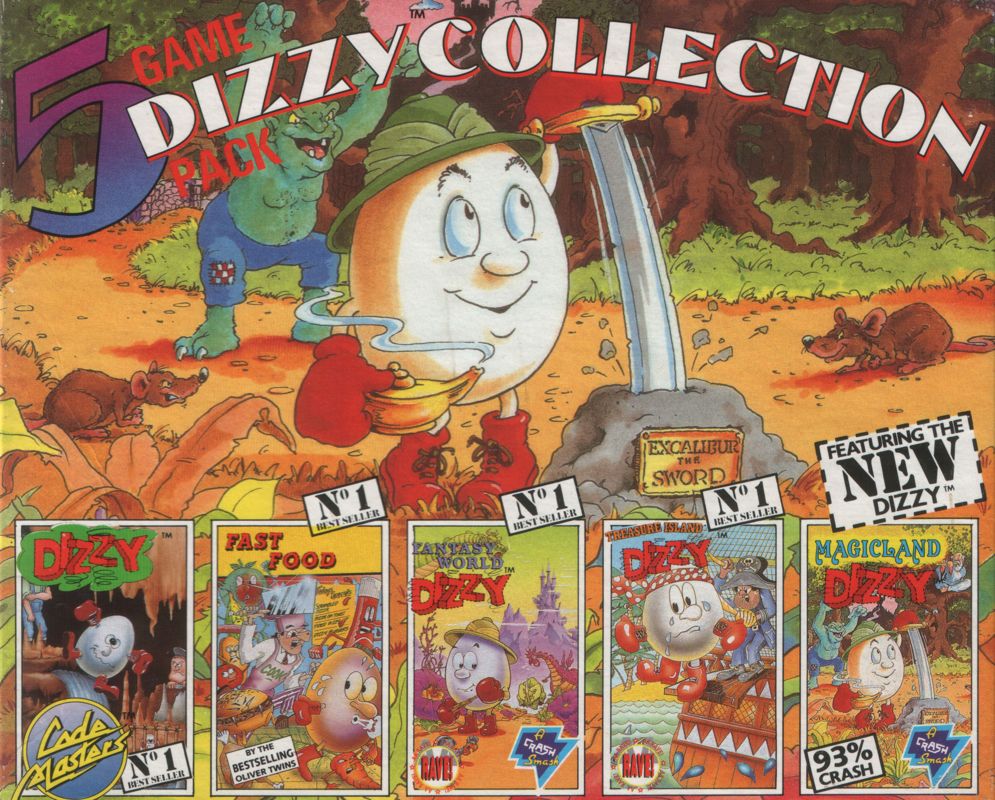Retro Replay Review
Gameplay
The Dizzy Collection delivers a diverse lineup of gameplay styles, ranging from maze-chase action to item-driven platform adventures. Fast Food channels the classic Pac-Man formula, tasking you with collecting all the scattered snacks while evading aggressive kitchen critters. On 16-bit platforms, the original Dizzy is swapped out for the Pengo-inspired Kwik Snax, introducing sliding block puzzles and a fresh arcade sheen.
(HEY YOU!! We hope you enjoy! We try not to run ads. So basically, this is a very expensive hobby running this site. Please consider joining us for updates, forums, and more. Network w/ us to make some cash or friends while retro gaming, and you can win some free retro games for posting. Okay, carry on 👍)
Once you move into the true Dizzy adventures—Treasure Island Dizzy, Fantasy World Dizzy, and Magicland Dizzy—the pace shifts to exploration and inventory-based problem solving. Each scene is packed with interactive objects, hidden passages, and light-tap combat against quirky foes. Progress hinges on finding the right sequence of items and deciphering environmental clues, rewarding patient players with satisfying “aha!” moments.
Controls remain tight and responsive across all five titles, whether you’re navigating Dizzy’s trademark egg form through perilous ledges or maneuvering the penguin blocks in Kwik Snax. The collision detection is forgiving enough for casual fans but precise enough to keep seasoned players on their toes. Difficulty ramps up steadily: early levels teach you the basics, while later stages demand careful planning and quick reflexes.
By packaging these varied formats together, the Dizzy Collection offers outstanding value for retro enthusiasts. You’ll spend dozens of hours hopping over spikes, outrunning ghosts, sliding ice blocks, and outwitting goblins—all in a single compilation. If you appreciate genre-hopping within a nostalgic framework, this set has something for every arcade-adventure palate.
Graphics
The pixel art in the Dizzy Collection captures the charm of late ’80s and early ’90s home computing. Each adventure sports a colorful, cartoonish palette that feels both timeless and evocative of the era. Dizzy’s expressive face and bouncy movements bring a surprising amount of personality to what is essentially an egg-shaped hero.
Fast Food and Kwik Snax ramp up the vibrancy with smooth animations and brightly outlined sprites that stand out crisply against darker backgrounds. In the adventure titles, hand-drawn set pieces brim with detail—from mossy caves and pirate ships in Treasure Island Dizzy to mushroom-studded woods and sparkling castles in Magicland Dizzy. The result is a cohesive visual identity that unites all five games.
Though you won’t find polygonal models or high-definition textures here, the collection’s graphics hold up remarkably well on modern displays. Pixel-perfect scaling and optional CRT filters preserve the retro aesthetic while avoiding the blurriness often seen in emulation. Overall, the visuals are a delightful throwback that reinforce each game’s lighthearted tone.
Story
Storytelling takes a backseat to puzzles and exploration, but the Dizzy titles boast more narrative charm than many contemporaries. In the original Dizzy (or Kwik Snax on 16-bit), the premise is deceptively simple: rescue Dizzy’s girlfriend Daisy by collecting keys and solving object-based puzzles. It sets the tone for the series’ blend of whimsy and minimalism.
Treasure Island Dizzy elevates the stakes with a full-blown pirate escapade, sending our hero in search of sunken loot and hidden map pieces. Subsequent entries—Fantasy World Dizzy and Magicland Dizzy—expand the universe further, introducing sorcerers, enchanted forests, and castle sieges. Each game feels like the next chapter in Dizzy’s ongoing quest, even as the core mechanics shift subtly from one adventure to the next.
Humor remains a constant thread throughout, with wry dialogue snippets, quirky NPCs, and playful item descriptions. While you won’t find cinematic cutscenes or voice acting, the clever writing and memorable characters invest the proceedings with personality. Even Fast Food and Kwik Snax, though more arcade-focused, include tongue-in-cheek messages that tie them back into the Dizzy brand.
Overall Experience
The Dizzy Collection stands out as a must-have for retro gaming fans and newcomers curious about the roots of arcade-adventure design. Its blend of puzzle-solving, platforming, and maze challenges delivers a well-rounded experience that rarely feels repetitive. With five distinct games in one package, you get a buffet of gameplay styles at an unbeatable price.
While some may find the difficulty curve steep—inventory puzzles can be merciless without a guide—this compilation rewards exploration and experimentation. Save states and rewinding features (where supported) make the tougher sections more approachable, ensuring you won’t lose hours of progress to a single misstep.
Audio complements the visuals with jaunty chiptune melodies and simple sound effects that underscore each game’s mood. Between Dizzy’s cheerful jingles, Fast Food’s frantic beeps, and the dream-like tunes of Magicland, the soundtrack ties the collection together gracefully.
In sum, the Dizzy Collection is an engaging anthology of classic arcade adventures wrapped in a polished modern shell. Whether you’re chasing ghosts in Fast Food, sliding blocks in Kwik Snax, or piecing together spells in Magicland Dizzy, this set delivers enduring charm and varied gameplay that stands the test of time.
 Retro Replay Retro Replay gaming reviews, news, emulation, geek stuff and more!
Retro Replay Retro Replay gaming reviews, news, emulation, geek stuff and more!




Reviews
There are no reviews yet.